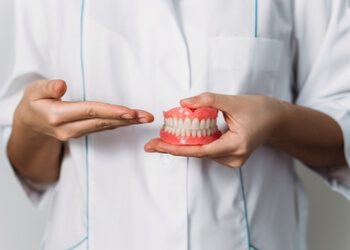
Have you ever wondered how to make your dentures fit better? If so, you’re certainly not alone. According to a recent report, one of the biggest complaints patients have about their dentures is that they don’t fit.
Dentures are a cost-effective replacement for teeth lost to gum disease, trauma, and tooth decay. However, loose or ill-fitting dentures can cause a lot of insecurity, not to mention discomfort. They may also impact your speech and ability to bite and chew your food.
Why do false teeth feel uncomfortable?
Patients struggle with loose or poorly fitting dentures for various reasons. It’s not uncommon for brand new dentures to feel uncomfortable in the mouth. They’re meant to fit snugly against the gums, so you may experience sore gums and have trouble speaking at first. After a few weeks, your dentist will schedule a follow-up appointment to check their fit and if any adjustments are needed. Other reasons for ill-fitting dentures include:
- Everyday wear and tear
- Bone recession
- Dentures have warped
How to make your dentures fit better and feel more comfortable – 3 Top tips
Choose the right adhesive – Not all denture adhesive suits all denture wearers. If your dentures slip or feel generally uncomfortable throughout the day, try changing your denture adhesive. The solution may be as simple as swapping a paste for a powder or a gel for a strip. Experiment with different adhesives for a week to see if it helps with the discomfort of ill-fitting dentures. Be aware that these products may not work if you have a dry mouth. Saliva acts as a natural adhesive system.
Take care of your dentures to keep them fitting well – The better you look after your dentures, the better they will fit. This is partly because handling them roughly can cause false teeth to bend or break. Left-over adhesive and food particles can also cause dentures to feel uncomfortable. Using the correct products and establishing a daily cleaning routine will help your dentures remain clean and comfortable to prevent potential mouth infections. While care and maintenance can’t magically improve ill-fitting dentures, they can help your dentures last longer.
Visit your dentist – When your dentures aren’t fitting properly, pay your dentist a visit. They can adjust the acrylic to prevent it from rubbing an area of your gums. They can also help make your dentures fit better with a reline. This entails adding a new layer of material to the base of your denture to improve the fit.
The new layer mirrors the contours of your mouth and gum line, causing your dentures to fit snugly again. Your dentist may also suggest implant-retained dentures to give your dentures a better fit.

Hopefully, you now know how to make your dentures fit better.
But if you’re still struggling, or your dentures need replacing, you might want to consider an alternative such as:
- Dental implants
- All-on-Four implants
- Bridges
Conclusion
If your dentures feel loose or are causing you pain, you really should try and make them fit better. Badly fitting dentures can cause several oral health problems, so it’s best to find a solution quickly. Of course, you should always speak to your dentist first to see if adjustments are necessary for your denture.
Why not book an appointment with the experienced, friendly dentists at My Local Dentists Northmead to see how we can help. We provide patients with high-quality natural-looking dentures, the latest dental implants, and dental bridges.
Call us on (02) 9630 9996 or use our online booking service. We’ll soon put a smile on your face.
References
Dental Products Report – 5 Biggest Complaints About Dentures
https://www.dentalproductsreport.com/view/5-biggest-patient-complaints-about-dentures-and-how-solve-them-0
Scielo Org – Saliva and Alternative Adhesive Systems for Complete Dentures
http://www.scielo.org.co/scielo.php?pid=S0121-246X2013000200012&script=sci_arttext&tlng=en
For.org – Implant Overdentures – introduction
https://www.for.org/en/treat/treatment-guidelines/edentulous/treatment-options/implant-prosthetics-removable/implant-overdenture-overview/implant-overdentures-introduction
